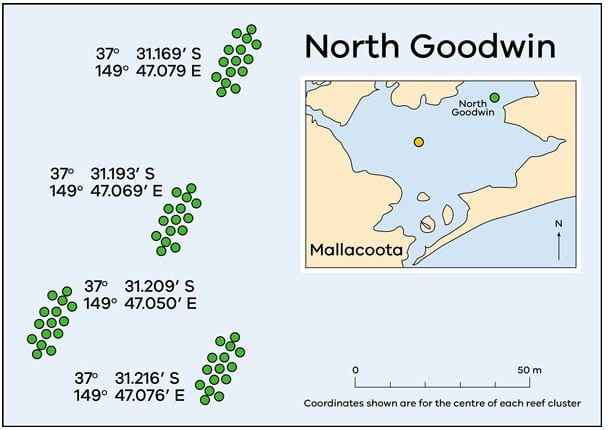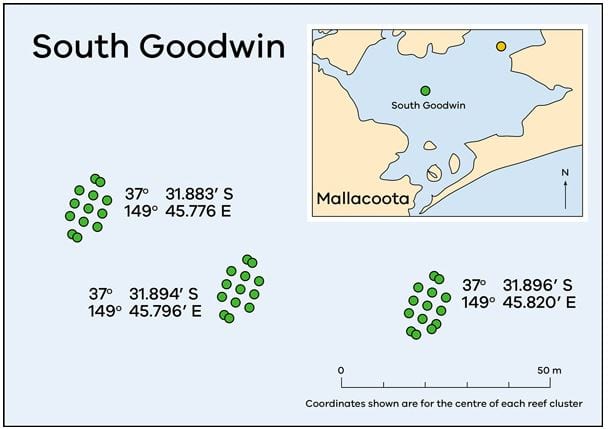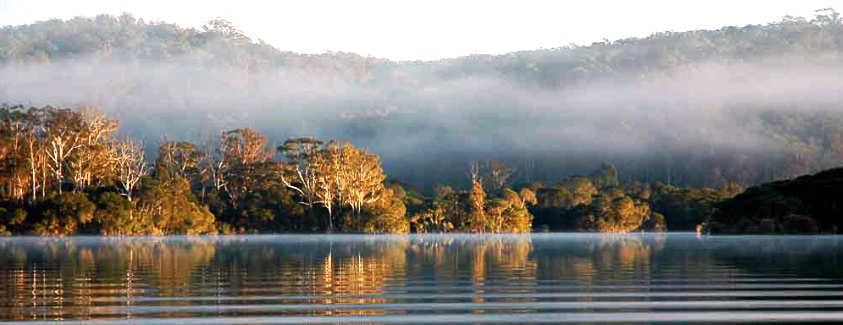Welcome to the Mallacoota Inlet Fishing Guide. Mallacoota is an exceptional all year round fishing destination located 6 ½ hours drive from Melbourne found just before the border of NSW. Located at the furthest eastern point of Gippsland within the Croajingolong National Park after passing other excellent fishing locations such as the Bemm River, Lakes Tyers, Marlo and more. The Mallacoota inlet feeds of the Bass strait which opens intermittently and can be quite challenging seas to navigate when it does. Once inside the Mallacoota Inlet passes scattered islands, multiple snaking channels, and a couple of artificial reefs before joining into the Genoa and Wallagaraugh Rivers.
**BECOME A FISHINGMAD MEMBER** Exclusive Fishing Workshops, Exciting Monthly Giveaways, In-Depth Fishing Reports with GPS Coordinates, Members Podcast, Interactive Maps, Catch of the Month Competitions, Kayak Club, Gear Guides, Rigging Tutorials, Tackle Talks, Sounder School, Fishing Tips, Fish Cleaning tutorials, Behind the scenes content & more.
Things to do at Mallacoota
Mallacoota is home to roughly 1,000 residents and welcomes a large volume of tourists annually. Therefore, there is plenty of decent accommodation options including powered and unpowered campsites, hotels and house rentals. There are grocery stores, pubs, cafes, bakeries, hardware stores, banks, petrol stations and tackle stores. Before entering the township, you drive through windy roads through scenic forest lands. Then finally reached the township which overlooks the bass strait coastline and over the Mallacoota inlet. Behind the inlet is the Cape Howe Wilderness Area which provides a beautiful setting and truly scenic fishing. The area is also well known for surfing, whale watching, the Mallacoota golf course home to many kangaroos, bushwalking, bike riding, and bird watching.
Besides fishing the lake system, you can launch at Bastion Point and fish offshore, surf fish along many of the spectacular beaches the region has to offer, watch whales passing by offshore, go on overnight hikes or bushwalks, go bike riding, surfing, bird watching, yachting or simply go for a drive to explore the scenery. It’s a hub of recreational activity.
Fishing the Mallacoota Inlet
Mallacoota Inlet is an exceptional bream fishery and home to many fishing tournaments locally including the Vic Bream Classic, Hobie Fishing series and ABT Australian Bream Tournaments. There are 2 main systems known as Top Lake and Bottom Lake, which are separated by a narrow stretch of water known as The Narrows. The choice of bream lures is almost endless to make things easier we created a detailed video on the best bream lures and how to use them. We also recommend reading our guide on the best lures to catch bream.
In Mallacoota, you will find yellowfin bream, black bream, trophy size dusky flathead, luderick, King George whiting, salmon, garfish and tailor. As you move further up towards the river you will also find estuary perch and bass. Towards the entrance, you will find mulloway, pinkie snapper and silver trevally, particularly within the deeper sections. Mallacoota offers a wide variety of fishing options for boats and kayaks. For those who will be land-based fishing, there are plenty of fishing platforms, and Gypsy point wharf provides excellent fishing access. Good baits here include sandworms, prawns, muscles, crab and frozen options including blue bait. They can also try their luck at surf fishing at the entrance beach or tip beach near the golf club.
Fishing with vibes and blades is a great option here as it allows you to target multiple species at once including bream flathead and tailor. These cast a fair distance, work well along drop-offs and can be fished slowly with hops, lifts and pauses. Good options here would include eco gear VX35s, strike pro micro vibe, Berkley big eye blades and TT switchblades. Lightly weighted soft plastics work well in the shallows where you flicking towards the banks or areas between 3 and 5 meters deep. Shallow diving hard body lures also work really well but will attract lots of attention from the aggressive tailor.
A large portion of the river is shallow and weedy and for this reason surface lures, shallow diving hard body lures, shallow diving cranks and very lightly weighted soft plastics will work well. usually using a 1/16 jig head and higher. Bream will congregate within the weed, edges and drop-offs so these are good areas to specifically target. In extremely weedy areas surface lures worked slowly work a treat you will also catch tailor and estuary perch with this method. When flicking lures and plastics you will need an ultralight spinning outfit. This would start with a light rod around 7 feet in length either a 1-3 or 2-4 kilo class. There are so many great options to choose from in this range which can be quite confusing for beginners. When choosing a reel make sure you pick a 1000, 2040 or 2500 size that is best, spooled with a 4-6 pound braid and finished with a 2 or 4-pound leader. Again the range of reels on the market is amazing and the budgets vary greatly depending on your skill level and spending habits.
If you plan on fishing with baits then we would highly recommend using Sandworms, maggots, scrub worms, pilchards, mussels, yabbies, & chicken. For bait fishing again a light rod setup is best. A 2-4 kilo class rod with a 2500 size reel would be a great option spooled with 6-pound line. Beginners can go a little heavier with a 3-5 kilo rod.
We would encourage you to watch our video below on how to catch bream with bait or read our detailed guide on Bait fishing for Bream.
Recommended baits Mallacoota Inlet
- yabbies
- Scrub worms
- sandworms
- maggots
- mussels
- pilchards
- prawns
Recommended lures and soft plastics Mallacoota Inlet
- Cranka crab
- Zman slim Swimz
- Berkley powerbait grub
- Damiki Monster Miki 2.5 sp
- Jackall Chubby
- Savage Gear Fathead Crank
- Daiwa Bait Junkie 2.5 inch grub
- Gulp 3-inch minnow
- Daiwa Bait Junkie paddle tail minnow
- Zman grubZ
- Squidge wrigglers
- eco gear ZX40
- Daiwa Double Clutch
- EcoGear SX40
- Squidges biotough grub
- Nories laydown minnow
- StrikePro cyber vibe
- Pro lure live yabby
- OSP bent minnows
- Hurricane twitch 50 shallow
Artificial reefs at Mallacoota


Targeting Bream at Mallacoota Inlet

This is a great location to target bream with lures and soft plastics. The options available are almost endless so make sure you read our guide on the best lures to catch bream. Recommended options include crab imitation, shallow diving cranks, paddle tail soft plastics, curl tail soft plastics, minnow imitations, vibes, and blades. Also, try your luck with surface lures which is an exciting form of fishing with light gear. Bream is all about finesse fishing so you will need an ultralight spin outfit. We recommend a 7-foot rod in a 1-3 or 2-4 kilo class, paired with a 1000, 2000 or 2500 reel spooled with a 2-6-pound braid and equivalent leader. There are so many amazing bream outfits on the market and budgets vary greatly depending on your skill level and spending habits.
Bream reside within the structure such as jetty pylons and stumps. Enticing them away from the structure onto your lure will take some time to master. Remember to work your lures and plastics slowly and mix up the retrieval techniques. If you are targeting bream with bait then we would highly recommend sandworms, maggots, scrub worms, mussels, yabbies, & chicken. A 2-4 kilo class rod paired with a 2500 size reel would be a great option spooled with a 6-pound line. We would encourage you to read our detailed guide on Bait fishing for Bream.
Targeting Estuary Perch at Mallacoota Inlet

Another highlight of fishing in this area is targeting Estuary perch with surface and shallow diving lures. The action can be frantic on warm balmy evenings with low wind. listen for the sound of breaking water which indicates EPs are feeding. The excitement an angler gets from an EP smashing a surface lure on light gear is something that truly needs to be experienced. It almost catches you by surprise when that aggressive strike comes. Small surface poppers, cicadas, blades, surface minnows and pencil lures work well here. So do shallow diving hardbody lures. Noteworthy options include bent minnows, Rapala countdown series, nories laydown minnows and shallow diving cranks. Basically, anything that doesn’t dive too deep and makes a good vibrating action will work well. You can use any colour choice we often start with silvers that mimic small baitfish or mullet.
EPs also respond incredibly well to a whole range of soft plastics lightly weighted. Including curl tails, paddle tails and minnow imitations. The trusty 2.5-inch grubs and minnows are an excellent choice. These imitate small baitfish that the EPs are actively feeding on. We would recommend mixing up the retrieval speeds and pauses and playing around with different colours. Where possible fish along the structure and stay alert for signs such as breaking water. Fishing for Estuary Perch requires finesse. We recommend an ultralight fishing combo consisting of a 1-3 or 2-4 kilo spin rod around 7 feet in length. Coupled with a 1000 or 2000 size reel spooled with 2-8 pound line and equivalent fluorocarbon leader. When bait fishing uses a 2-4 kilo rod around 7 feet in length. Coupled with a 2500 size reel either a float or small running sinker to a swivel and very fine leader.
Targeting Poddy Mullet at Mallacoota Inlet

Poddy Mullet are a fascinating species. The school is up in massive numbers and grow up to 75cm in length. They frequently jump out of the water and create an amazing spectacle for onlooking anglers. They are a dream to catch as they are strong, fast and like steam trains go on massive bursts of big runs of energy. The fascination for the species is how to catch them. I have seen schools of thousands of poddy mullet swim right past a well-presented bait or lure right in front of them. However, we have had some success using small paddle tail and grub soft plastics with scent applied. Catching them with light spinning gear is great fun and they will put your reel through its paces.
Targeting Flathead at Mallacoota Inlet

We encourage you to read our detailed guide on How to catch Flathead. Flathead is a year-round prospect that can be caught at any time of the day. They are an ambush predator that waits in disguise for smaller fish to swim by for an easy feed. This highlights the importance of keeping your baits and soft plastics towards the bottom. If fishing from a boat or kayak we would recommend drifting around the sandy flats until you find a good patch of them. Also, keep an eye for depth drop-offs which is a great location for an ambush predator to be waiting.
We recommend targeting flathead with a 7 foot 2–4 or 3-5 kilo fishing rod paired with a 2500 or 3000 size reel spooled with 8-12lb braid and equivalent leader. You can go lighter, but flathead has bristly teeth that can compromise your fishing line. Flathead is not fussy and will happily have a go at many various soft plastics and lures. We would highly recommend reading our detailed guide on the best lures and soft plastics to catch flathead. Top choices include worm and yabby imitations, paddle tail soft plastic, curl tail soft plastics, deep diving hard body lures, vibes, swimbaits, and blades. If you are targeting flathead with bait, we recommend using a paternoster rig or running sinker rig. Use a small ball sinker to swivel, then 50cm of 8-12 leader to a size 6 long shank hook. Good baits choices include pilchards, mussels, squid, chicken, whitebait, Pipis, blue bait and prawns.
Targeting Tailor at Mallacoota Inlet

A tailor is an aggressive predatory fish with sharp teeth that fight hard. They have a similar profile to a salmon and leap out of the water when hooked. They school up in big numbers hunting baitfish in packs and breaking water often a sign that there feeding. You can catch them trolling, casting lures or bait fishing from the banks or surf. Small metal slugs, curl tail soft plastics, paddle tail soft plastics are great choices. So is full pilchard mullet, blue bait and garfish. Either on a single hook, ganged hooks and even on light wire trace if there cutting through your leaders.
Picking a suitable outfit for a tailor can be tricky as they have sharp teeth and can shred your leaders with ease. When fishing in estuary systems we would typically use a 7-foot rod in a 2-4, 3-5 or 4-6 kilo class, paired with a 2500 or 3000 reel spooled with 6-8-pound braid and slightly stronger leader. If your targeting them in the surf then a long casting surf rod spooled with 14-20 pound braid and equivalent leader would be suitable. Handle carefully they have sharp teeth that can do some damage. If you’re getting hook-ups but dropping a lot of fish then consider using a stronger leader or light wire trace. Any time of day, though some fish will be more active at Dawn and Dusk. Always be careful when the river entrance opens. During this time the tidal flow can be very strong and quite dangerous. Like all rural areas always take notice of areas that might hold snakes.
We recommend watching our guide on great lures to catch bream.
Images of fish supplied VFA and DEPI. All other images and videos shown on the Mallacoota Inlet Fishing Guide are Fishing Mad originals.
Thank you for visiting the Mallacoota Inlet Fishing Guide. If you feel this location guide is missing any key information or needs any corrections made, then please let us know by emailing our team at enquiries@fishingmad.com.au with specific details in the email. Thank you


